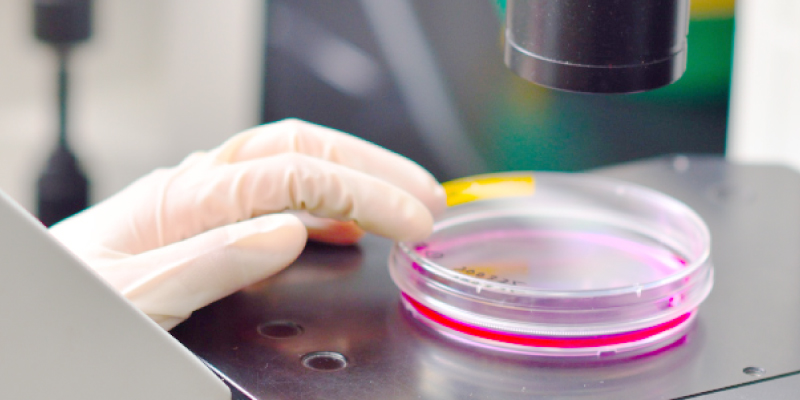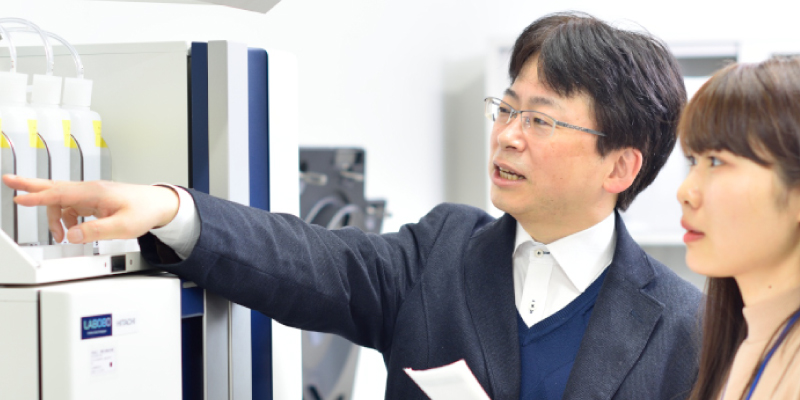
Overview of the Department of Bioscience
The Department of Bioscience trains students for careers in fields ranging from medicine and pharmacy to food, energy, and the environment by helping them master a comprehensive range of specialized bioscience knowledge and technologies through basic research on the genetic level.
The Department of Bioscience offers four courses. Students pursue a common curriculum through the first semester of their third year and then select a course to explore in detail.
Thanks to specialized subjects and lab courses related to bioinformatics, students can augment their use of biotechnology in the laboratory by mastering fundamental knowledge in this field and its applications through a rich, computer-intensive course of study.
Learning opportunities in the Department of Bioscience
The shape and behavior of all living things are determined by genes that are unique to the species in question. Genes, which serve as the blueprint for life, control the synthesis of protein molecules, playing an indispensable role in life activity and giving shape to cells based on the blueprint. Cells are the smallest unit of life. With the exception of single-cell organisms, large numbers of diverse cells come together to form tissues and organs, comprising the living organisms around us. These individual organisms in turn gather to form biological communities (ecosystems), interacting not only with the surrounding physical environment, but also with other organisms to form the magnificent biosphere--the Earth on which we live. In this way, the living world constitutes a hierarchical structure that leads from genes to protein molecules to cells to individuals to a biological community (the environment) that is shared by all life on the planet Earth.
Bioscience, the study of life, can be considered to be a new academic discipline that is founded on research results from the conventional academic fields of biology, chemistry, and physics. The Department of Bioscience has adopted a course structure that transcends domains such as science, engineering, agriculture, medical science, and pharmacy to implement a curriculum based on the equivalence of the concept of life with living organisms. Enabling students to embark on a comprehensive, systematic study are four courses--the Genomics Course, Proteomics Course, Cell Biology Course, and Environmental Biology Course--which cover subject matter ranging from genetic information and protein and metabolite function to cellular life activities and the mechanisms of ecosystem networks. The newly created Department of Animal Bioscience is responsible for study and research at the organism level, and a range of broad, deep partnerships serves to advance students' understanding of life itself.

Genomics Course
Searching for genetic information, the blueprint of life,through gene engineering
The current flourishing of biotechnology would have been impossible without the establishment of the revolutionary technologies of gene engineering: cloning, base sequence determination, and gene amplification.
The Genomics Course provides thorough instruction in key technologies, from the basics of gene engineering to state-of-the-art knowledge. Its goal is to train hands-on professionals with the "venture spirit" through basic research in areas such as the molecular analysis of plant information transmission systems using gene engineering technologies, immunological research focusing on antibodies, and investigations of the mechanisms by which viral pathogens manifest
themselves; research and development of drugs targeting causative molecules by means of the genome and proteome drug discovery method; and applied research into areas such as a super-high-speed DNA amplification method combining gene engineering and nanotechnology, the creation of new virus detection technologies, and its application to DNA-based authentication methods.
Proteomics Course
Elucidating the mechanisms of life with molecules and creating new biomolecules in "molecule workshops"
Proteins, which are straight-chain polymers consisting of more than 20 amino acids, are important molecules that serve as the building blocks of life, as suggested by proteios, the word's Greek origin (meaning "principal" or "first"). Proteins play a central role in the life activities of all organisms, including human beings.
In recent years, a complete picture of proteins and other mol-ecules that make life possible has emerged thanks to rapid developments in the field of biotechnology.
The Proteomics Course seeks to learn about the proteins that are so important to us and thereby to understand the nature of life. In particular, students explore ways of effectively utilizing proteins by investigating the mechanisms of life through the development of research methods and technologies for elucidating the function and structure of proteins and other biomolecules.
Cell Biology Course
Exploring the "factory" of life activities, a mysterious microcosm
Our bodies consist of some 60 trillion cells representing more than 200 discrete types. These cells form tissues and organs, which carry on a wide variety of life activities. Inside cells can be found a range of organelles such as the nucleus, endoplasmic reticulum, Golgi bodies, and mitochondria, forming a mysterious microcosm: the "factory" of life activities.
In the Cell Biology Course, students study how cells produce energy to carry out life activities and how proteins are formed in the cell to regulate its various functions while learning about intracellular material transport systems, the life and death of organelles, intercellular communication, and the mechanisms by which cells create tissues and organs. Further, they master fundamental knowledge and skills for developing new technologies such as cell culture and recombinant DNA experiments in the use of cells to efficiently produce useful substances and in regenerative medicine
Environmental Biology Course
Explaining the phenomena of life at the molecular level in the organisms that form ecosystems
The Earth is home to a vast variety of living organisms, which comprise rich ecosystems that exist in harmony with the environment. The Environmental Biology Course conducts research with the goal of understanding how organisms recognize the environment in ecosystems and harmonize their activities using the language of molecules.
For example, the course covers research into the mechanisms by which animals recognize and respond to external stimuli such as light, and research into the effects of endocrine disruptors flowing into rivers, lakes, and marshes on fish and other wildlife and the mechanisms by which those effects are carried out. Other projects in which department are enthusiastically involved include research into the mechanisms of plant environmental recognition and plant immunity to pathogenic bacteria, research into the physiological mechanisms of microorganisms and the control of their lifespans, and research into the various physiologically active substances that are created by organisms in the environment.
We consider research in areas such as these to provide a basis for maintaining ecosystems that are rich in life into the indefinite future.






